Zeolitic Imidazolate Framework-8 Composite-Based Enzyme-Linked Aptamer Assay for the Sensitive Detection of Deoxynivalenol
Abstract
:1. Introduction
2. Materials and Methods
2.1. Reagents
2.2. Apparatus
2.3. Preparation of the AuNPs and HRP&Au@ZIF-8/cDNA Composites
2.4. Construction of the Colorimetric ELAA Based on HRP&Au@ZIF-8/cDNA for DON Detection
2.5. Preparation of the Spiked Cereal Samples
2.6. Statistical Analysis
3. Results and Discussion
3.1. Detection Principle of the Colorimetric ELAA Based on HRP&Au@ZIF-8/cDNA
3.2. Characterization of the HRP&Au@ZIF-8 Composites
3.3. Optimization of Detection Parameters
3.4. Performance of the Colorimetric ELAA Based on the HRP&Au@ZIF-8/cDNA Composites for DON Detection
3.5. Evaluation of the Assay Specificity
3.6. Stability Analysis
3.7. Actual Cereal Sample Analysis
4. Conclusions
Supplementary Materials
Author Contributions
Funding
Institutional Review Board Statement
Informed Consent Statement
Data Availability Statement
Acknowledgments
Conflicts of Interest
References
- Qu, J.; Xie, H.; Zhang, S.; Luo, P.; Guo, P.; Chen, X.; Ke, Y.; Zhuang, J.; Zhou, F.; Jiang, W. Multiplex flow cytometric immunoassays for high-throughput screening of multiple mycotoxin residues in milk. Food Anal. Methods 2019, 12, 877–886. [Google Scholar] [CrossRef]
- Mishra, S.; Srivastava, S.; Dewangan, J.; Divakar, A.; Kumar Rath, S. Global occurrence of deoxynivalenol in food commodities and exposure risk assessment in humans in the last decade: A survey. Crit. Rev. Food Sci. Nutr. 2022, 60, 1346–1374. [Google Scholar] [CrossRef]
- Wei, T.; Ren, P.; Huang, L.; Ouyang, Z.; Wang, Z.; Kong, X.; Li, T.; Yin, Y.; Wu, Y.; He, Q. Simultaneous detection of aflatoxin B1, ochratoxin A, zearalenone and deoxynivalenol in corn and wheat using surface plasmon resonance. Food Chem. 2019, 300, 125176. [Google Scholar] [CrossRef] [PubMed]
- Sobrova, P.; Adam, V.; Vasatkova, A.; Beklova, M.; Zeman, L.; Kizek, R. Deoxynivalenol and its toxicity. Interdiscip. Toxicol. 2010, 3, 94–99. [Google Scholar] [CrossRef] [PubMed]
- Feizollahi, E.; Jeganathan, B.; Reiz, B.; Vasanthan, T.; Roopesh, M. Reduction of deoxynivalenol during barley steeping in malting using plasma activated water and the determination of major degradation products. J. Food Eng. 2023, 352, 111525. [Google Scholar] [CrossRef]
- Sokolović, M.; Šimpraga, B. Survey of trichothecene mycotoxins in grains and animal feed in Croatia by thin layer chromatography. Food Control 2006, 17, 733–740. [Google Scholar] [CrossRef]
- Dai, H.; Huang, Z.M.; Liu, X.D.; Bi, J.; Shu, Z.X.; Xiao, A.H.; Wang, J.H. Colorimetric ELISA based on urease catalysis curcumin as a ratiometric indicator for the sensitive determination of aflatoxin B1 in grain products. Talanta 2022, 246, 123495. [Google Scholar] [CrossRef]
- Huang, Z.M.; Shu, Z.X.; Xiao, A.H.; Pi, F.W.; Li, Y.B.; Dai, H.; Wang, J.H. Determination of aflatoxin B1 in rice flour based on an enzyme-catalyzed Prussian blue probe. LWT-Food Sci. Technol. 2022, 162, 113500. [Google Scholar] [CrossRef]
- Kudłak, B.; Wieczerzak, M. Aptamer based tools for environmental and therapeutic monitoring: A review of developments, applications, future perspectives. Crit. Rev. Environ. Sci. Technol. 2020, 50, 816–867. [Google Scholar] [CrossRef]
- Majdinasab, M.; Ben Aissa, S.; Marty, J.L. Advances in colorimetric strategies for mycotoxins detection: Toward rapid industrial monitoring. Toxins 2020, 13, 13. [Google Scholar] [CrossRef]
- Zhao, Q.; Lu, D.; Zhang, G.Y.; Zhang, D.; Shi, X.B. Recent improvements in enzyme-linked immunosorbent assays based on nanomaterials. Talanta 2021, 223, 121722. [Google Scholar] [CrossRef] [PubMed]
- Bilal, M.; Barceló, D.; Iqbal, H.M. Nanostructured materials for harnessing the power of horseradish peroxidase for tailored environmental applications. Sci. Total Environ. 2020, 749, 142360. [Google Scholar] [CrossRef] [PubMed]
- Yang, K.; Chen, G.N.; Wang, L.; Guo, M.; Xu, J.M.; Ma, Y.R.; Luo, Z.M.; Zeng, A.G.; Fu, Q. Zeolitic-imidazolate framework (ZIF-8)-based immobilized multi-enzyme integrated with colorimetric sensor for cholesterol assay. New J. Chem. 2023, 47, 4103–4112. [Google Scholar] [CrossRef]
- Xu, S.; Qi, H.; Zhou, S.; Zhang, X.; Zhang, C. Mediatorless amperometric bienzyme glucose biosensor based on horseradish peroxidase and glucose oxidase cross-linked to multiwall carbon nanotubes. Microchim. Acta 2014, 181, 535–541. [Google Scholar] [CrossRef]
- Li, F.; Ma, W.; Liu, J.; Wu, X.; Wang, Y.; He, J. Luminol, horseradish peroxidase, and glucose oxidase ternary functionalized graphene oxide for ultrasensitive glucose sensing. Anal. Bioanal. Chem. 2018, 410, 543–552. [Google Scholar] [CrossRef]
- Cui, J.; Ren, S.; Sun, B.; Jia, S. Optimization protocols and improved strategies for metal-organic frameworks for immobilizing enzymes: Current development and future challenges. Coord. Chem. Rev. 2018, 370, 22–41. [Google Scholar] [CrossRef]
- Chulkaivalsucharit, P.; Wu, X.; Ge, J. Synthesis of enzyme-embedded metal–organic framework nanocrystals in reverse micelles. RSC Adv. 2015, 5, 101293–101296. [Google Scholar] [CrossRef]
- Dai, H.; Wu, X.Y.; Duan, S.; Li, Z.M.; Zhang, Q.; Shen, Y.F.; Bi, J.; Shu, Z.X.; Xiao, A.H.; Pi, F.W.; et al. An electrochemical sensor based on curcumin-encapsulated zeolitic imidazolate framework-8 for the sensitive determination of aflatoxin B1 in grain products. Microchem. J. 2023, 191, 108852. [Google Scholar] [CrossRef]
- Duan, S.; Wu, X.Y.; Shu, Z.X.; Xiao, A.H.; Chai, B.; Pi, F.W.; Wang, J.H.; Dai, H.; Liu, X.D. Curcumin-enhanced MOF electrochemical sensor for sensitive detection of methyl parathion in vegetables and fruits. Microchem J. 2023, 184, 108182. [Google Scholar] [CrossRef]
- Yuan, Z.; Dai, H.; Liu, X.; Duan, S.; Shen, Y.; Zhang, Q.; Shu, Z.; Xiao, A.; Wang, J. An electrochemical immunosensor based on prussian blue@ zeolitic imidazolate framework-8 nanocomposites probe for the detection of deoxynivalenol in grain products. Food Chem. 2023, 405, 134842. [Google Scholar] [CrossRef]
- Liang, K.; Coghlan, C.J.; Bell, S.G.; Doonan, C.; Falcaro, P. Enzyme encapsulation in zeolitic imidazolate frameworks: A comparison between controlled co-precipitation and biomimetic mineralisation. Chem. Commun. 2016, 52, 473–476. [Google Scholar] [CrossRef] [PubMed]
- Liu, X.; Qi, W.; Wang, Y.; Lin, D.; Yang, X.; Su, R.; He, Z. Rational design of mimic multienzyme systems in hierarchically porous biomimetic metal–organic frameworks. ACS Appl. Mater. Interfaces 2018, 10, 33407–33415. [Google Scholar] [CrossRef] [PubMed]
- Shaban, S.M.; Kim, D.-H. Recent advances in aptamer sensors. Sensors 2021, 21, 979. [Google Scholar] [CrossRef] [PubMed]
- Song, S.P.; Wang, L.H.; Li, J.; Fan, C.H.; Zhao, J.L. Aptamer-based biosensors. TrAC Trends Anal. Chem. 2008, 27, 108–117. [Google Scholar] [CrossRef]
- Lv, M.Z.; Zhou, W.; Tavakoli, H.; Bautista, C.; Xia, J.F.; Wang, Z.H.; Li, X.J. Aptamer-functionalized metal-organic frameworks (MOFs) for biosensing. Biosens. Bioelectron. 2021, 176, 112947. [Google Scholar] [CrossRef]
- Kadam, U.S.; Hong, J.C. Advances in aptameric biosensors designed to detect toxic contaminants from food, water, human fluids, and the environment. Trends Environ. Anal. Chem. 2022, 36, e00184. [Google Scholar] [CrossRef]
- Paul, A.; Vyas, G.; Paul, P.; Srivastava, D.N. Gold-nanoparticle-encapsulated ZIF-8 for a mediator-free enzymatic glucose sensor by amperometry. ACS Appl. Nano Mater. 2018, 1, 3600–3607. [Google Scholar] [CrossRef]
- Wang, D.S.; Li, Y.D. One-pot protocol for Au-based hybrid magnetic nanostructures via a noble-metal-induced reduction process. J. Am. Chem. Soc. 2010, 132, 6280–6281. [Google Scholar] [CrossRef]
- Yin, Z.C.; Lin, M.J.; Xu, Y.; Wang, Z.Y.; Cai, Y.R.; Yang, X.G. Enzyme and Au nanoparticles encapsulated ZIF-8 for glucose responsive closed-loop drug delivery. Mater. Lett. 2021, 301, 130276. [Google Scholar] [CrossRef]
- Nadar, S.S.; Rathod, V.K. Immobilization of proline activated lipase within metal organic framework (MOF). Int. J. Biol. Macromol. 2020, 152, 1108–1112. [Google Scholar] [CrossRef]
- Yang, J.; Zhang, F.J.; Lu, H.Y.; Hong, X.; Jiang, H.L.; Wu, Y.; Li, Y.D. Hollow Zn/Co ZIF particles derived from core–shell ZIF-67@ ZIF-8 as selective catalyst for the semi-hydrogenation of acetylene. Angew. Chem. Int. Edit. 2015, 127, 11039–11043. [Google Scholar] [CrossRef]
- Liu, J.; Zhang, N.L.; Li, J.S.; Li, M.Y.; Wang, G.X.; Wang, W.L.; Fan, Y.X.; Jiang, S.; Chen, G.L.; Zhang, Y. A novel umami electrochemical biosensor based on AuNPs@ ZIF-8/Ti3C2 MXene immobilized T1R1-VFT. Food Chem. 2022, 397, 133838. [Google Scholar] [CrossRef] [PubMed]
- Banga, I.; Paul, A.; Muthukumar, S.; Prasad, S. ZENose (ZIF-based electrochemical nose) platform for noninvasive ammonia detection. ACS Appl. Mater. Interfaces 2021, 13, 16155–16165. [Google Scholar] [CrossRef] [PubMed]
- Wang, X.; Shan, Y.; Gong, M.; Jin, X.; Jiang, M.; Xu, J. A novel electrochemical sensor for ochratoxin A based on the hairpin aptamer and double report DNA via multiple signal amplification strategy. Sens. Actuators B-Chem. 2019, 281, 595–601. [Google Scholar] [CrossRef]
- Liu, G.; Wang, L.; Zhu, F.; Liu, Q.; Feng, Y.; Zhao, X.; Chen, M.; Chen, X. Facile construction of a reusable multi-enzyme cascade bioreactor for effective fluorescence discrimination and quantitation of amino acid enantiomers. Chem. Eng. J. 2022, 428, 131975. [Google Scholar] [CrossRef]
- Bastami, T.R.; Dabirifar, Z. AuNPs@PMo12 nanozyme: Highly oxidase mimetic activity for sensitive and specific colorimetric detection of acetaminophen. RSC Adv. 2020, 10, 35949–35956. [Google Scholar] [CrossRef]
- Wang, L.; Zhi, W.; Lian, D.; Wang, Y.; Han, J.; Wang, Y. HRP@ ZIF-8/DNA hybrids: Functionality integration of ZIF-8 via biomineralization and surface absorption. ACS Sustain. Chem. Eng. 2019, 7, 14611–14620. [Google Scholar] [CrossRef]
- Liang, K.; Ricco, R.; Doherty, C.M.; Styles, M.J.; Bell, S.; Kirby, N.; Mudie, S.; Haylock, D.; Hill, A.J.; Doonan, C.J.; et al. Biomimetic mineralization of metal-organic frameworks as protective coatings for biomacromolecules. Nat. Commun. 2015, 6, 7240. [Google Scholar] [CrossRef]
- Jiang, Q.; Jian, D.W.; Yao, K.; Yin, Y.L.; Gong, M.M.; Yang, C.B.; Lin, F. Paper-based microfluidic device (DON-Chip) for rapid and low-cost deoxynivalenol quantification in food, feed, and feed ingredients. ACS Sens. 2019, 4, 3072–3079. [Google Scholar] [CrossRef]
- Yu, S.C.; He, L.L.; Yu, F.; Liu, L.; Qu, C.L.; Qu, L.B.; Liu, J.; Wu, Y.M.; Wu, Y.J. A lateral flow assay for simultaneous detection of Deoxynivalenol, Fumonisin B1 and Aflatoxin B1. Toxicon 2018, 156, 23–27. [Google Scholar] [CrossRef]
- Beloglazova, N.; Lenain, P.; Tessier, M.; Goryacheva, I.; Hens, Z.; De Saeger, S. Bioimprinting for multiplex luminescent detection of deoxynivalenol and zearalenone. Talanta 2019, 192, 169–174. [Google Scholar] [CrossRef] [PubMed]
- Guo, R.; Ji, Y.; Chen, J.N.; Ye, J.; Ni, B.X.; Li, L.; Yang, Y. Multicolor visual detection of deoxynivalenol in grain based on magnetic immunoassay and enzymatic etching of plasmonic gold nanobipyramids. Toxins 2023, 15, 351. [Google Scholar] [CrossRef] [PubMed]
- Maria-Hormigos, R.; Gismera, M.J.; Sevilla, M.T.; Rumbero, A.; Procopio, J.R. Rapid and easy detection of deoxynivalenol on a bismuth oxide screen-printed electrode. Electroanalysis 2017, 29, 60–66. [Google Scholar] [CrossRef]
- Sun, J.D.; Wang, L.Z.; Shao, J.D.; Yang, D.D.; Fu, X.R.; Sun, X.L. One-step time-resolved fluorescence microsphere immunochromatographic test strip for quantitative and simultaneous detection of DON and ZEN. Anal. Bioanal. Chem. 2021, 413, 6489–6502. [Google Scholar] [CrossRef]
- Li, R.X.; Meng, C.Z.; Wen, Y.; Fu, W.; He, P.L. Fluorometric lateral flow immunoassay for simultaneous determination of three mycotoxins (aflatoxin B1, zearalenone and deoxynivalenol) using quantum dot microbeads. Microchim. Acta 2019, 186, 748. [Google Scholar] [CrossRef]
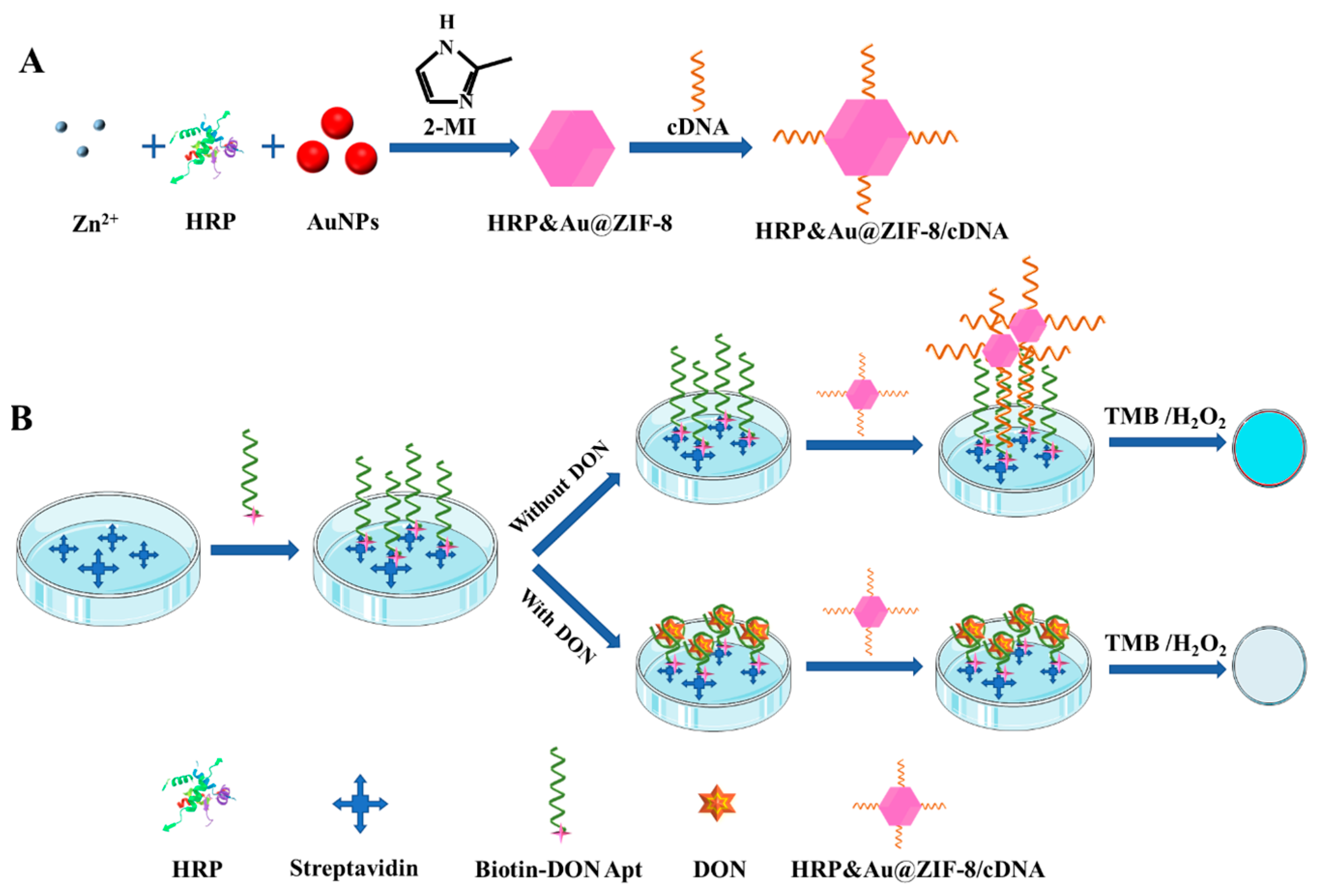
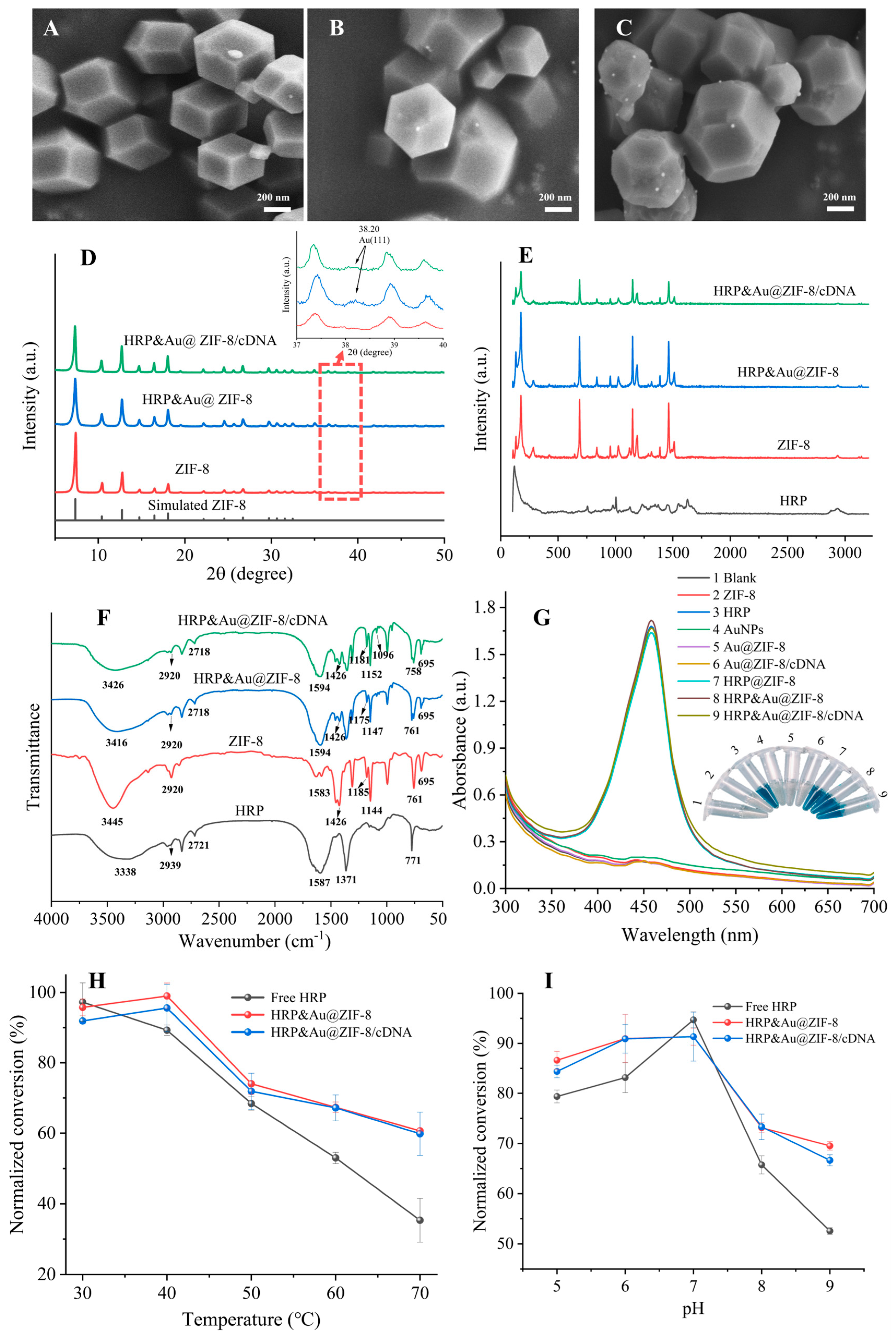
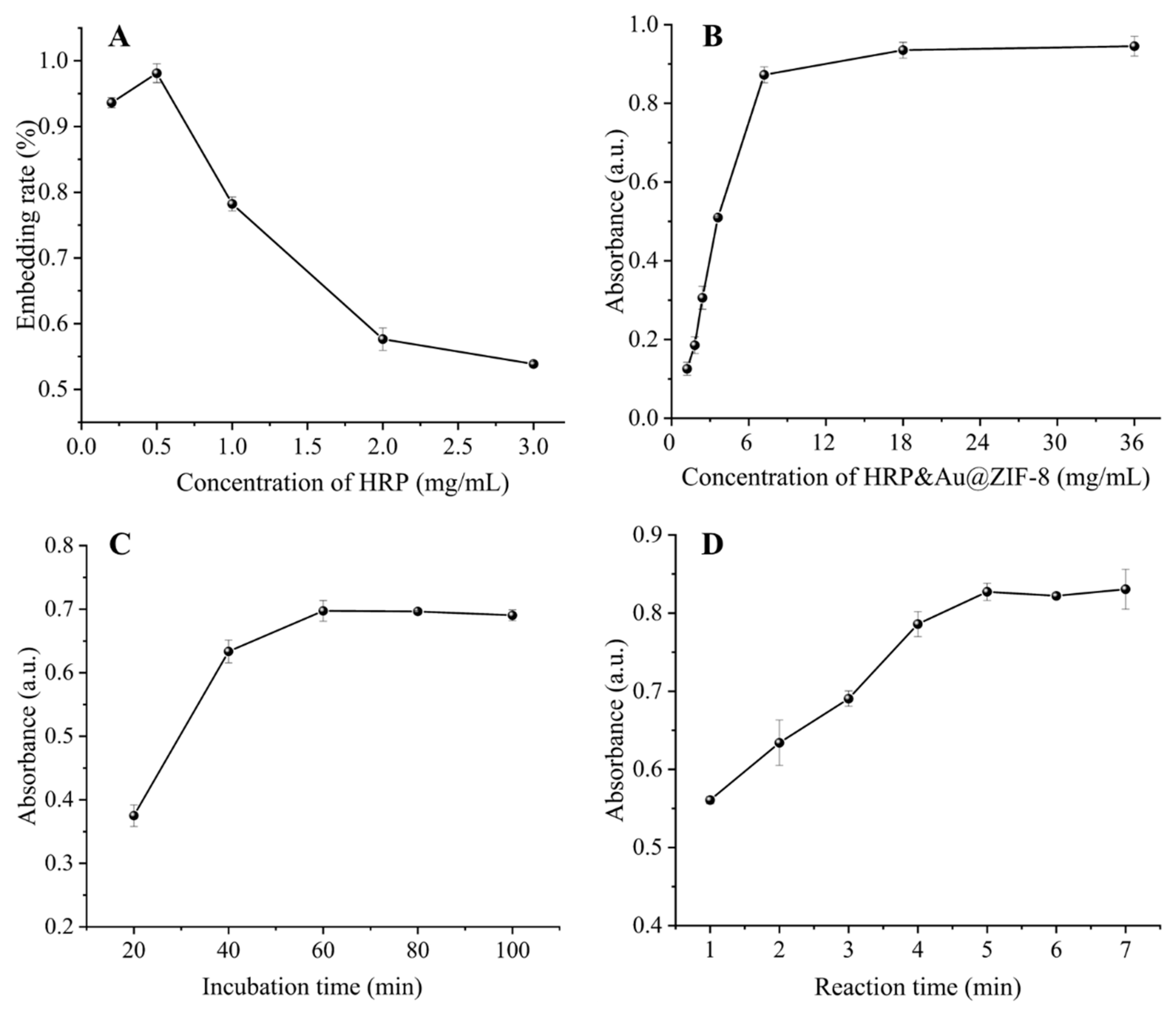
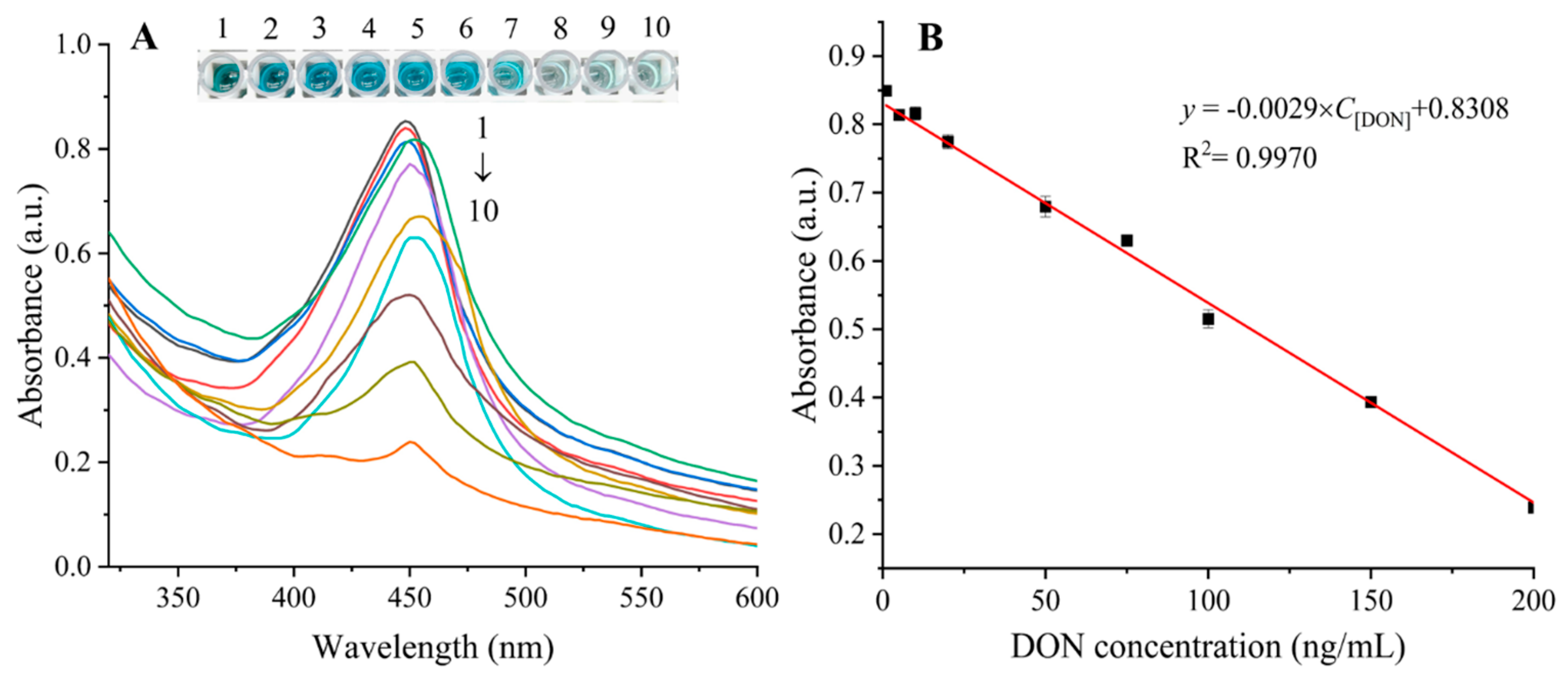
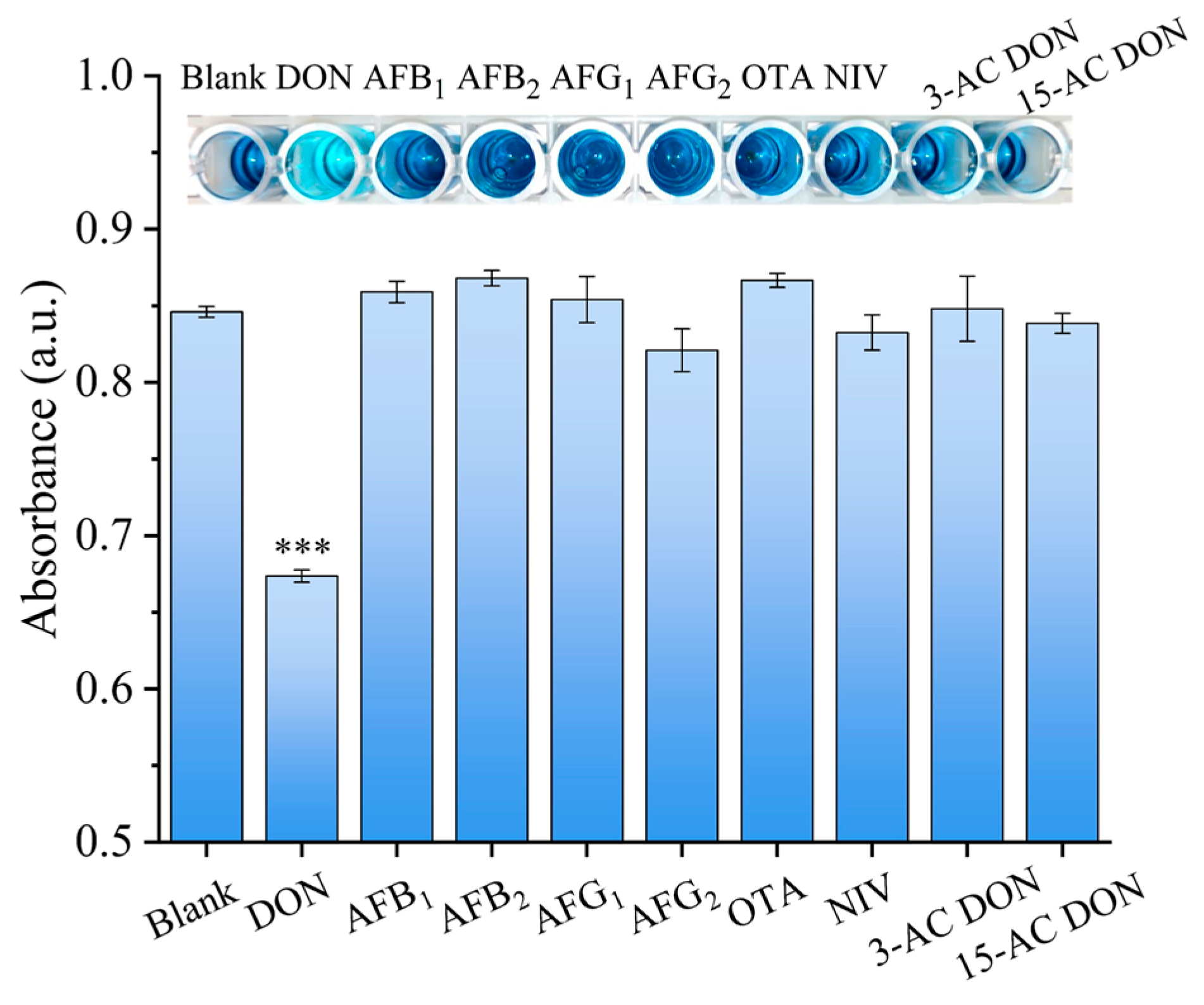
| Samples | Spiked Concentration (ng/mL) | Measured Concentration (Mean ± SD a) (ng/mL) | Recovery b (%) | RSD c (%) | ELISA Validation (Mean ± SD) (ng/mL) | Recovery (%) | RSD (%) |
|---|---|---|---|---|---|---|---|
| Rice flour | 1 | 1.01 ± 0.05 | 101.15 | 4.95 | − | − | − |
| 10 | 9.76 ± 0.13 | 97.59 | 1.33 | 10.01 ± 0.17 | 100.12 | 1.70 | |
| 50 | 52.00 ± 0.87 | 104.00 | 1.67 | 50.16 ± 0.79 | 100.31 | 1.57 | |
| 100 | 100.99 ± 2.20 | 100.99 | 2.18 | 109.85 ± 0.66 | 109.85 | 0.60 | |
| 200 | 198.59 ± 7.13 | 99.29 | 3.59 | 199.89 ± 1.33 | 99.95 | 0.67 | |
| Wheat flour | 1 | 1.10 ± 0.05 | 110.34 | 4.55 | − | − | − |
| 10 | 10.38 ± 0.11 | 103.77 | 1.06 | 10.10 ± 0.19 | 100.95 | 1.88 | |
| 50 | 50.91 ± 0.93 | 101.82 | 1.83 | 53.25 ± 0.69 | 106.49 | 1.30 | |
| 100 | 99.12 ± 1.41 | 99.12 | 1.42 | 100.84 ± 1.42 | 100.84 | 1.41 | |
| 200 | 191.99 ± 7.13 | 95.99 | 3.71 | 196.35 ± 3.36 | 98.18 | 1.71 | |
| Maize flour | 1 | 0.86 ± 0.02 | 86.21 | 2.33 | − | − | − |
| 10 | 9.75 ± 0.07 | 97.50 | 0.72 | 10.91 ± 0.19 | 109.07 | 1.74 | |
| 50 | 48.09 ± 1.04 | 96.18 | 2.16 | 51.56 ± 0.43 | 103.12 | 0.83 | |
| 100 | 101.88 ± 0.95 | 101.88 | 0.93 | 110.54 ± 2.80 | 110.54 | 2.53 | |
| 200 | 209.43 ± 8.21 | 104.71 | 3.92 | 201.75 ± 1.51 | 100.87 | 0.75 |
Disclaimer/Publisher’s Note: The statements, opinions and data contained in all publications are solely those of the individual author(s) and contributor(s) and not of MDPI and/or the editor(s). MDPI and/or the editor(s) disclaim responsibility for any injury to people or property resulting from any ideas, methods, instructions or products referred to in the content. |
© 2023 by the authors. Licensee MDPI, Basel, Switzerland. This article is an open access article distributed under the terms and conditions of the Creative Commons Attribution (CC BY) license (https://creativecommons.org/licenses/by/4.0/).
Share and Cite
Shu, Z.; Zhou, R.; Hao, G.; Tang, X.; Liu, X.; Bi, J.; Dai, H.; Shen, Y. Zeolitic Imidazolate Framework-8 Composite-Based Enzyme-Linked Aptamer Assay for the Sensitive Detection of Deoxynivalenol. Biosensors 2023, 13, 847. https://doi.org/10.3390/bios13090847
Shu Z, Zhou R, Hao G, Tang X, Liu X, Bi J, Dai H, Shen Y. Zeolitic Imidazolate Framework-8 Composite-Based Enzyme-Linked Aptamer Assay for the Sensitive Detection of Deoxynivalenol. Biosensors. 2023; 13(9):847. https://doi.org/10.3390/bios13090847
Chicago/Turabian StyleShu, Zaixi, Run Zhou, Guijie Hao, Xingyue Tang, Xin Liu, Jie Bi, Huang Dai, and Yafang Shen. 2023. "Zeolitic Imidazolate Framework-8 Composite-Based Enzyme-Linked Aptamer Assay for the Sensitive Detection of Deoxynivalenol" Biosensors 13, no. 9: 847. https://doi.org/10.3390/bios13090847
APA StyleShu, Z., Zhou, R., Hao, G., Tang, X., Liu, X., Bi, J., Dai, H., & Shen, Y. (2023). Zeolitic Imidazolate Framework-8 Composite-Based Enzyme-Linked Aptamer Assay for the Sensitive Detection of Deoxynivalenol. Biosensors, 13(9), 847. https://doi.org/10.3390/bios13090847





